Research Highlights
-
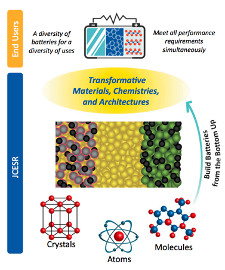
Energy storage emerging: A perspective from the Joint Center for Energy Storage Research
As part of the National Academy of Sciences colloquium, “Status and Challenges in Decarbonizing our Energy Landscape,” the Joint Center for Energy Storage Research leadership published this perspective on energy storage solutions that are emerging and how many solutions are needed to fulfill the varied application needs today and in the future. Read More
-
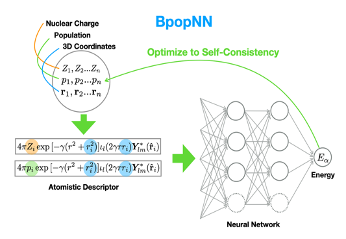
Incorporating Electronic Information into ML PESs via Approaching the Ground-State Electronic Energy as a Function of Atom-Based Electronic Populations
DFT is a primary tool for studying the electronic properties of materials. DFT’s description can be simplified to be based on elementary electronic features of the material’s atoms. We use ML to model this description. This is a novel way to incorporate electronic information, e.g. polarization, into ML potential energy surface (PES) approximations. Read More
-
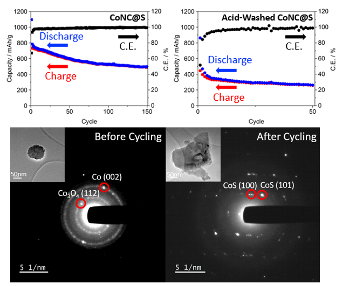
Conversion of Co Nanoparticles to CoS in MOF-Derived Porous Carbon During Cycling Facilitates Na2S Reactivity in a Na-S battery
A MOF-derived Co nanoparticle-embedded nitrogen-doped porous carbon (CoNC) was utilized as a catalytic sulfur cathode host for Na-S battery. Postmortem characterization suggests that Co nanoparticles convert to CoS during cycling, and CoS is responsible for catalytic activity on sulfur. Read More
-
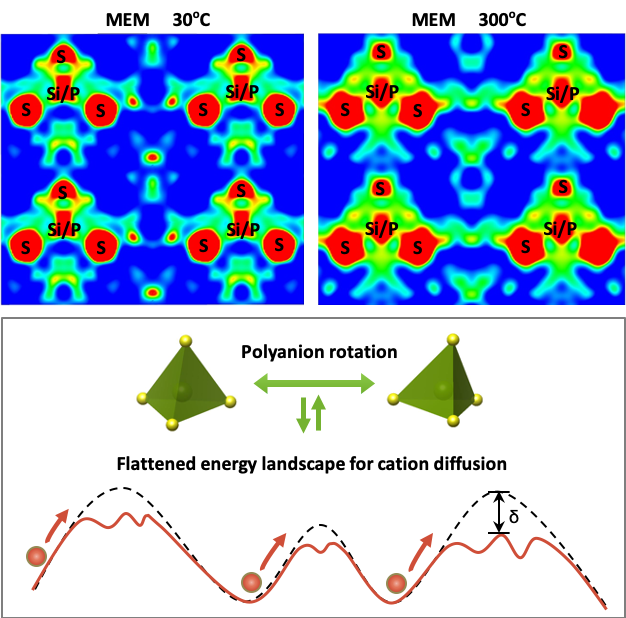
Targeting Superionic Conductivity by Turning on Anion Rotation at Room Temperature in Fast Ion Conductors
Using the maximum entropy method and AIMD calculations, we demonstrate that both the high-temperature phase, b-Li3PS4, and its room temperature Li-stuffed counterpart, Li3.25Si0.25P0.75S4 exhibit anion rotation which increases Li-cation diffusivity. Read More
-
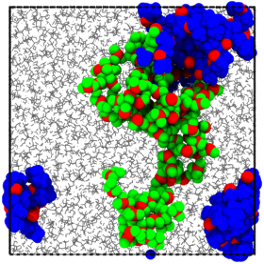
Origin of Unusual Acidity and Li+ Diffusivity in a Series of Water-in-Salt Electrolytes
The origin of strong acidity and explanation of ion diffusion along nanometric channels were uncovered in an important family of LiTFSI/H2O water-in-salt electrolytes (WiSEs). Read More
-

Oxyfluorides with new structural phenomena and anion dynamics
The compound families (i) (Rb/NH4/Tl)MoO2F3, (ii) K5[Mo3O4F9]·3H2O, K5[Mo3O4F9]·2H2O, K16[Mo3O4F9]2[TiF6]3·2H2O, and (iii) Δ,Λ-[Cu(bpy)2(H2O)]2[(Ti/Zr/Hf)F6]2 were synthesized by hydro(solvo)thermal methods, and their atomic structures were solved with single-crystal X-ray diffraction and solid-state 19F NMR spectroscopy. These materials exhibit unique features such as (i) periodic tendril perversion (a reversal in helical chirality) along a 1D chain, (ii) metal–metal bonded heteroanionic clusters, or (iii) noncentrosymmetric crystallization of racemic mixtures. Read More
-

Defect-Induced Anisotropic Surface Reactivity and Ion Transfer Processes of Anatase Nanoparticles
The role of vacancy defects in charge transfer and interfacial reaction processes were unveiled for anatase TiO2 nanoparticle surfaces using multimodal analysis with lithium bis(trifluoromethanesulfonyl)imde (Li-TFSI) as a probing molecule. Read More
-

Impact of anion shape on Li+ solvation and on transport properties for lithium-air batteries: a molecular dynamics study
MD simulations show that the ionic dynamics of electrolyte solutions can be similar even though the Li+ solvation in each solution is different. Read More
-

Accelerating the Discovery of Energy Storage Materials via AI-guided Computational Framework
An AI-guided quantum mechanical simulation framework was developed to identify homobenzylic ethers (HBEs) of desired oxidation potentials with 5-fold efficiency improvement over a brute force approach. Read More
-

Crossover mitigation strategies for redox-flow batteries
Reviewed causes and effects of crossover in different types of flow batteries and discussed strategies to reduce crossover and mitigate its impact on performance and durability. Read More
Latest Updates
-
You’re Invited - JCESR and Beyond: Translating the Basic Science of Batteries
Please join us at Argonne National Laboratory on Tuesday, April 4, 2023 for JCESR and Beyond: Translating the Basic Science of Batteries. Registration is now open. This in-person event will celebrate 10 years of research from the Joint Center… Read More
-
A Message from JCESR: In Memory of George Crabtree
It is with heavy hearts that we say goodbye to George Crabtree, a Senior Scientist and Distinguished Fellow at Argonne National Laboratory, and Director of the Joint Center for Energy Storage Research (JCESR), who passed away unexpectedly on January 23. Dr. Read More
-
Cyanopyridines As Extremely Low-Reduction-Potential Anolytes for Nonaqueous Redox Flow Batteries
Discovery of a cyanophenylpyridine derivative with a very low reduction potential and good stability during cycling. Read More
-
Characterizing Redoxmer – Electrode Kinetics Using a SECM-Based Spot Analysis Method
Identified asymmetries in electron transfer (ET) kinetics between the reduction and oxidation of ferrocene-based redoxmers by measuring the ET rate constants (kf/kb) as a function of electrode potential. Read More
-
Benzotriazoles as Low Potential Anolytes for Non-Aqueous Redox Flow Batteries
We developed an easy-to-synthesize benzotriazole-based anolyte with a high energy redox potential (-2.3 V vs Fc/Fc+) and high solubility that demonstrates stable electrochemical cycling performance. Read More

